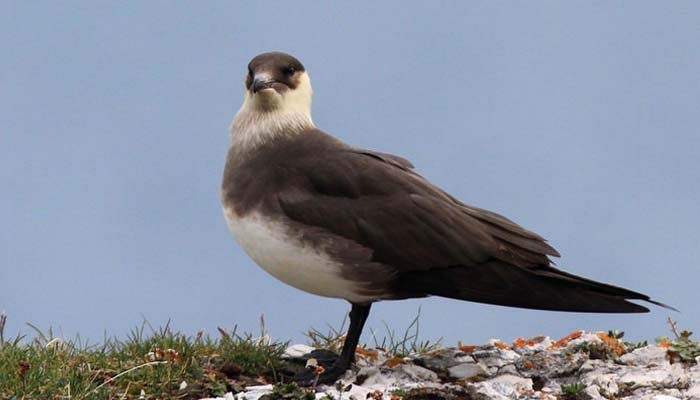
English: Pomarine
Jaeger, Pomarine Skua
Russian: Средний поморник
Mongolian: Бэсрэг хайлгана, Бэсрэг хулгайч цахлай
German: Spatelraubmowe
French: Labbe pomarin
Japanese: トウゾクカモメ (Tozoku-kamome)
Body length: 42-50 cm.
Wing span: 115-125 cm.
Breeds on arctic tundra; passes N and W Europe on
migration, mostly in May and Oct-Nov, to and from winter areas e.g. off W
Africa. Rare
but regular on passage in Britain & Ireland. Usually seen singly or in small
groups, sometimes very large parties (50+). Juveniles can be quite fearless.
Identification:
In flight, appears definitely larger than Common Gull and slightly smaller than
Herring Gull. On the ground surprisingly small, smallest birds appear hardly as
big as Kittiwakes but always look heavy-crested. Long-winged; ‘arm’ rather
broad, appears somewhat wider than distance from rear edge of wing to tip of
tail (projections disregarded); ‘hand’ pointed, much as on Arctic Skua. Flight
relaxed and steady, wingbeats measured and path more direct, light and jerky
with energetic wingbeats as sometimes with Arctic. In all plumages, light
primary patch above and below roughly as on Arctic and considerably less than
on normal Great.
- Adult
summer: Long and broad tail projections, look blunt-ended in profile (central
tail-feathers twisted 90°; ‘carries a spoon’); moulted twice annually, Nov-Dec
and Mar-Apr (and at other times very rarely broken off). Two morphs: light
(commoner) has dark cap (reaches below gape), dark and coarse breast-band (on ♂
fairly often broken on centre of breast, and can be missing), insignificant or
prominent barring of flanks, and extensive dark vent distinctly demarcated
(element of light barring on many); dark morph is all dark (except for wing
patches)
- Juvenile:
Varying from mid brown with yellowish-buff bars, especially on rump and vent,
to uniform dark blackish-brown, but almost always looks dark in the field. Told
from similar juvenile Arctic Skua by calmer, more steady flight; broader ‘arm’;
fuller belly; heavier bill being more noticeably pale blue-grey (readily
visible at 300 m), tipped dark; light morph has pale ‘double patch’ on
underwing, i. e. both primaries and primary-coverts basally light on most (hard
to judge beyond 300 m); and blunt-ended, broad central tail-feathers which
project only insignificantly, if at all. Juvenile practically never has
strongly contrasting pale head or belly (cf. Arctic and Long-tailed). Darkest
dark morphs unbarred like dark adult. 2nd cal.-year, light morph: Neck and
belly paler, central tail-feathers shortish or half-length and not twisted. 3rd
cal.-year, light morph: Neck and belly pale, dark cap beginning to show, but
underwing-coverts still barred, not all dark as on adult.
- Adult
winter, light morph: Similar to 3rd cal.-year, tail projection being
half-length, but told by all dark, unbarred underwing-coverts.